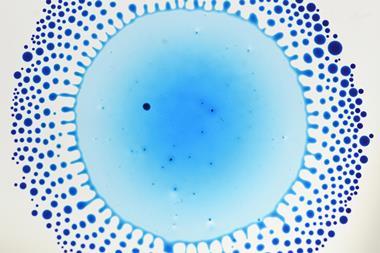Discovery could herald sprays that hoover up dirt and keep solar panels clean
Researchers have solved the puzzle of a remarkable phenomenon that allows droplets of water mixed with a food colouring to move spontaneously and freely in intricate patterns when placed on a clean glass slide. The work could lead to novel applications, including autonomous sensing, fluidic machines and self-cleaning systems.
The phenomenon was first noticed by researchers in Manu Prakash’s lab at Stanford University, US, and it has captured their curiosity ever since. Three years and hundreds of experiments later they’ve now worked out why the droplets move and interact, allowing precise control over them. In one example, the team made different coloured droplets self-sort into their particular colour. They can also be made to repel or merge with other droplets.
Controlling droplets precisely usually requires engineering complex patterns onto a surface. Without this, droplets fall foul of an effect known as contact line pinning – the reason why rain droplets stick to windows – which limits droplet movement. However, Prakash’s team demonstrated that droplets could move freely on clean surfaces, including glass slides, unhindered by pinning. The researchers found that the reason comes down to the droplets being made from two miscible liquids – such as water and food colouring containing propylene glycol (PG).
Experiments showed these binary fluid droplets don’t stick and become pinned to surfaces thanks to the formation of a surface tension gradient between the water and the PG. This gradient occurs because water evaporates faster from the edge of the drop than the centre. This causes water to flow from the low surface tension area at the droplet’s edge to the high surface tension region in the centre, which almost totally suppresses pinning.
As the droplets are not pinned, they can start to move around thanks to differences in the amount of vapour emitted by neighbouring droplets. They effectively ‘communicate’ with each other via mass transfer of water molecules from one drop to another, which creates an imbalance in the rate of evaporation, and thus surface tensions, on opposite sides of a single droplet. Such asymmetry provides the necessary force for drops to move towards each other, akin to how some cells and organisms move in response to chemical stimuli.
Fundamental rule
‘What we describe is a fundamental rule for all binary fluids; so many kinds of binary fluids could utilise these properties,’ says Prakash. ‘We believe that having the capacity to remove contact line pinning in droplets is very significant, since you can suddenly make fluids self-motile. Both in the field of microfluidics and self-cleaning surfaces, these properties are immensely useful.’
‘The work is beautiful, it’s a breakthrough,’ says Manoj Chaudhury, who investigates drop fluidics at Lehigh University, US. ‘This way of creating motion of drops on a surface can have interesting applications. One application is to be able to move drops on a surface without a pumping mechanism, which will have applications in microfluidics and microscale reaction engineering.’
Chaudhury explains that one drop may have one chemical and the other drop may have another chemical. When they are released on the surface, they will approach each other and fuse allowing a chemical reaction to take place.
Prakash’s team exploited these properties to make self-assembling liquid lenses, comprising droplets that can work together to produce a focused image. He envisages it could be useful for many other applications including self-cleaning systems. ‘Imagine a solar array that self-cleans itself by a simply spraying it with this binary fluid solution of PG and water. Since these droplets are self-motile and extract the energy to move from the environment, they naturally move around, pick up all the dirt and keep the surface clean – a very important requirement for solar panels and arrays to work with high efficiency.’












No comments yet